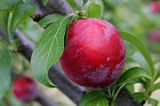
Prunus domestica
Encyclopedia
Prunus domestica is a Prunus
species with many varieties. These are often called "plums" in common English, though not all plum
s belong to this species. Its hybrid parentage is believed to be Prunus spinosa
and Prunus cerasifera var. divaricata. This is the most commonly grown plum at least in Europe
, and most prune
s (dried plums) are made from fruits of this species.
The subspecies cross easily, so that numerous intermediate forms can be found: their sweetness and tartness may vary, their colors varying from bluish purple, to red, orange, yellow or light green.
Prunus
Prunus is a genus of trees and shrubs, which includes the plums, cherries, peaches, apricots and almonds. There are around 430 species spread throughout the northern temperate regions of the globe. Many members of the genus are widely cultivated for fruit and ornament.-Botany:Members of the genus...
species with many varieties. These are often called "plums" in common English, though not all plum
Plum
A plum or gage is a stone fruit tree in the genus Prunus, subgenus Prunus. The subgenus is distinguished from other subgenera in the shoots having a terminal bud and solitary side buds , the flowers in groups of one to five together on short stems, and the fruit having a groove running down one...
s belong to this species. Its hybrid parentage is believed to be Prunus spinosa
Prunus spinosa
Prunus spinosa is a species of Prunus native to Europe, western Asia, and locally in northwest Africa. It is also locally naturalised in New Zealand and eastern North America....
and Prunus cerasifera var. divaricata. This is the most commonly grown plum at least in Europe
Europe
Europe is, by convention, one of the world's seven continents. Comprising the westernmost peninsula of Eurasia, Europe is generally 'divided' from Asia to its east by the watershed divides of the Ural and Caucasus Mountains, the Ural River, the Caspian and Black Seas, and the waterways connecting...
, and most prune
Prune
A prune is any of various plum cultivars, mostly Prunus domestica or European Plum, sold as fresh or dried fruit. The dried fruit is also referred to as a dried plum...
s (dried plums) are made from fruits of this species.
Characteristics
Typically it forms a large shrub or a small tree. It may be somewhat thorny, with white flowers, borne in early spring. The fruit varies in size, but can be up to 8 cm across, and is usually sweet, but can be rather acid in some varieties.Subspecies
The European Garden Flora recognises three subspecies, though scientific studies favor a more fine-grained separation:- P. domestica ssp. domestica – common plums, zwetschge (including ssp. oeconomica)
- P. domestica ssp. insititia – damsonDamsonThe damson or damson plum is an edible drupaceous fruit, a subspecies of the plum tree. Sometimes called the Damask plum, damsons are commonly used in the preparation of jams and jellies...
s (Damask plums) and bullaceBullaceThe bullace is a variety of plum. It bears edible fruit similar to those of the damson, and like the damson is considered to be a strain of the insititia subspecies of Prunus domestica...
s - P. domestica ssp. intermedia – egg plums (including Victoria plumVictoria plumThe Victoria plum is a a type of English plum. It has a yellow flesh with a red or mottled skin. This plum is a cultivar of the egg plum group ....
) - P. domestica ssp. italica – gages (greengageGreengageThe greengages, also known as the Reine Claudes, are the edible drupaceous fruits of a cultivar group of the common European plum. The first true greengage was bred in Moissac, France, from a green-fruited wild plum originally found in Asia Minor; the original greengage cultivar nowadays survives...
s, round plums etc; including sspp. claudiana and rotunda) - P. domestica ssp. pomariorum – spilling
- P. domestica ssp. prisca – zibarte
- P. domestica ssp. syriaca – mirabelle plumMirabelle plumThe mirabelle plum, also known as the mirabelle prune , is the edible drupaceous fruit of the mirabelle prune tree, a cultivar of the plum tree of the genus Prunus...
s
The subspecies cross easily, so that numerous intermediate forms can be found: their sweetness and tartness may vary, their colors varying from bluish purple, to red, orange, yellow or light green.

